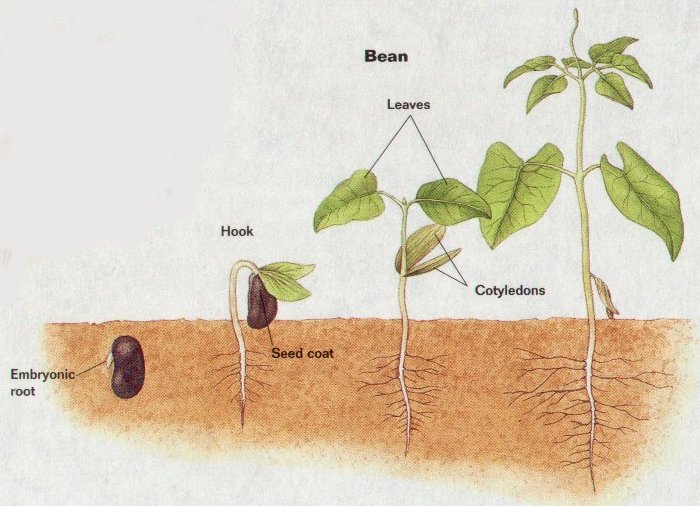STUDENTS’ CHAMBER: TYPES OF SEED GERMINATION
GROWTH AND DEVELOPMENT IN FLOWERING PLANTS
TYPES OF SEED GERMINATION
THERE are two types of seed germination namely hypogeal germination and epigeal germination.
(I) HYPOGEAL GERMINATION
Hypogeal germination is the type of germination in which the seed cotyledons remain underground the soil. It occurs in monocotyledonous plants such as maize, wheat, millet and some dicotyledonous plant e.g pigeon peas.
The part of the embryo that elongates is the epicotyl. The epicotyl elongates rapidly raising the plumule above the soil while the cotyledons remain below the underground level.
Food stored in the cotyledons is used for respiration by the cells and for new tissue formation.
The shoot is pushed through the soil particles. In maize the plumule sheath known as coleoptiles protects the plumule. The coleoptile grows towards the light. The foliage leaves emerge through the split end of the coleoptile, it carries out photosynthesis, while the radicle as it emerges through the maize grain by a sheath called coleorhiza.
(II)EPIGEAL GERMINATION
Epigeal germination is the type of germination in which the cotyledons are brought above the soil level. This type of germination occurs in dicotyledonous plants such as beans and some monocotyledonous plant such as an onion.
In a dicotyledonous seed, the plumule and radicle are attached to the two cotyledons. The hypocotyl elongates rapidly raising the cotyledons into the air. The hypocotyl is the region of the stem beneath the cotyledons and directly above the young root of a seedling.
The epicotyl is the region of the shoot of a seedling which is found above the cotyledon of the embryo.
The seed absorbs water and softens the testa, the cotyledons wall swell and rupture the testa. That process makes a radicle to elongate and emerges through the seed coat. A root develops from the radicle.
The hypocotyl elongates rapidly and develops a curvature. The curved part emerges above the soil. The hypocotyl eventually straightens, raising the cotyledons and plumule above the soil. The cotyledons are also known as seed leaves.
The cotyledons enlarge and turn green to carry out photosynthesis. The epicotyl elongates thus increasing the height of the seedling. The first foliage leaves emerge.
The cotyledons shrivel as the stored food materials are used up. The first foliage leaves enlarge and start carrying out photosynthesis.
CHANGES OCCURING DURING SEED GERMINATION
(a). Germination is triggered by the entry of water into the seed through the micropyle. It absorbs from the surrounding areas.
(b). Water softens the testa. The cells become turgid as they take in water .The turgidity ruptures the softened testa.
(c). The water dissolves food substances so that they can be transported to the growing parts.
(d). Energy released during respiration is used for growth, it is also needed for making cell walls.
(e). The proteins stored in the seed are broken down into amino acids. Amino acids are an important component in the synthesis of cell membranes and cytoplasm.
(f). The radicle forces its way out of the testa and the plumule elongates and emerges above the ground.
JIBU maswali yote kwenye ukurasa huu ili ujishindie zawadi za vifaa mbalimbali vya shule, kama daftari, mathematical sets, vitabu na kadhalika kutoka kwa mdhamini wetu, Chilu Latest Wear wauzaji wa nguo za kisasa waliopo Kariakoo, Mtaa wa Mchikichi na Msimbazi pamoja na Temeke Mwisho, Mtaa wa Likwati.
Tuma majibu yako kwenda namba 0719401968, kwa maswali yanayohusu michoro, tuma mchoro wako kwa WhatsApp kwa namba hii. Washindi watakuwa wakitangazwa na kukaabidhiwa zawadi zao kupitia ukurasa huu.




Comments are closed.